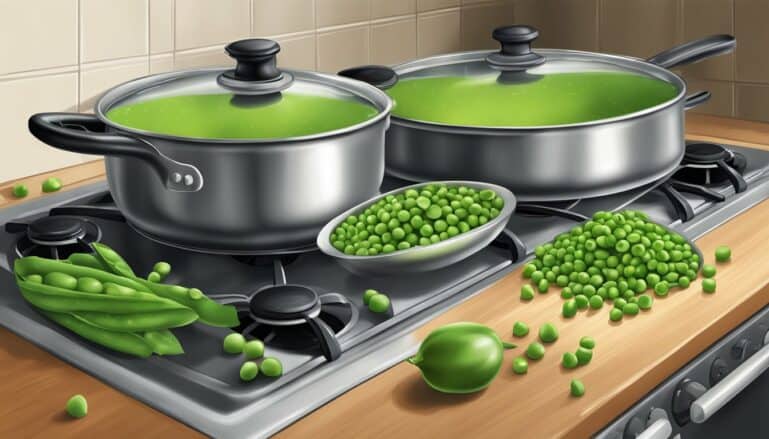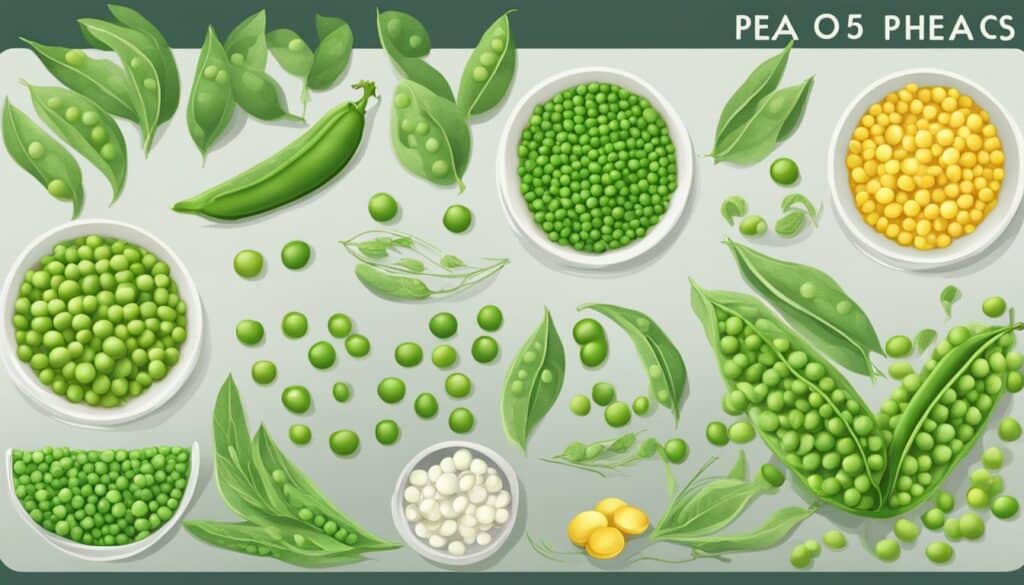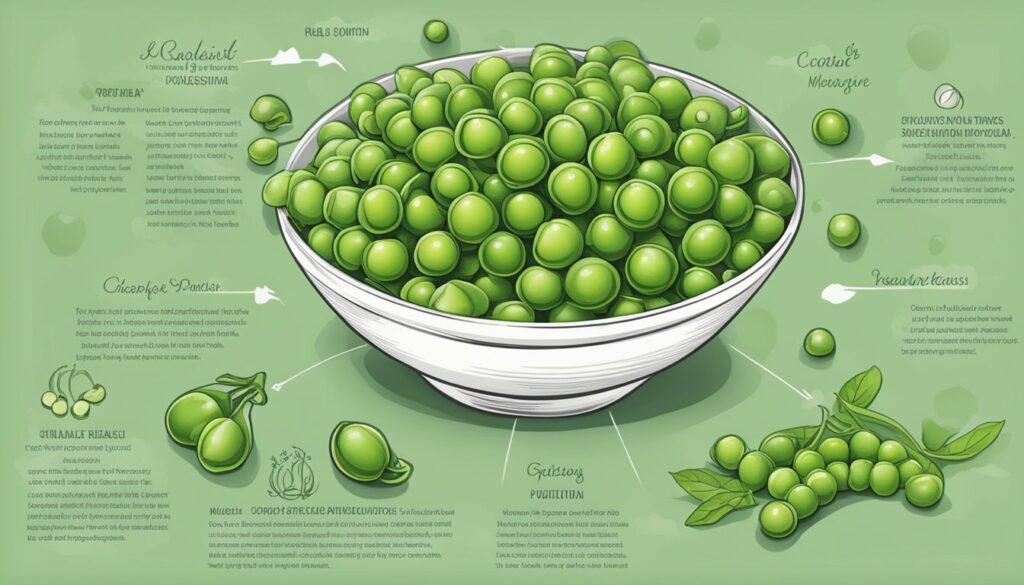How to Cook Peas: A Simple Guide for Perfectly Cooked Peas Every Time

Table of Contents
Understanding Peas
Peas are a type of legume that are commonly used in cooking. They come in a variety of forms, including fresh, frozen, snap, sweet, snow, garden, and English peas. Each type has its own unique flavor and texture.
Fresh peas are harvested from the pod and are typically available in the spring and summer months. They are sweet and tender, making them a great addition to salads and side dishes.
Frozen peas are a convenient alternative to fresh peas and are available year-round. They are picked at their peak and immediately frozen to preserve their flavor and texture.
Snap peas, also known as sugar snap peas, are a cross between snow peas and garden peas. They have a crisp texture and sweet flavor, making them a popular snack or addition to salads.
Sweet peas, also known as English peas, are a classic variety of pea that are often used in soups and stews. They have a slightly starchy texture and a sweet, delicate flavor.
Snow peas, also known as Chinese pea pods, are flat and crunchy with a mild, sweet flavor. They are often used in stir-fries and salads.
Garden peas, also known as shelling peas, are the most common variety of pea. They have a sweet, slightly starchy flavor and are often used in soups, stews, and side dishes.
Overall, peas are a nutritious and versatile ingredient that can add flavor and texture to a variety of dishes.
Nutritional Value of Peas
Peas are a great source of nutrition and offer many health benefits. Here are some key nutritional facts about peas:
- Peas are low in calories, with just 62 calories per 100 grams.
- They are low in fat, with only 0.4 grams of fat per 100 grams.
- Peas are high in fiber, with 5.1 grams of fiber per 100 grams.
- They are also a good source of protein, with 5.4 grams of protein per 100 grams.
- Peas are low in sodium and high in potassium, which can help regulate blood pressure.
- They are a good source of carbohydrates, with 11 grams of carbohydrates per 100 grams.
- Peas are low in sugars, with only 4.5 grams of sugars per 100 grams.
- They are cholesterol-free, making them a heart-healthy food choice.
- Peas are also a good source of iron, which is important for healthy blood.
Overall, peas are a nutritious and tasty addition to any meal. Whether you enjoy them fresh, frozen, or canned, they offer a range of health benefits that make them a great choice for anyone looking to improve their diet.
Types of Peas and Their Uses
When it comes to cooking peas, there are several types of peas that can be used in various dishes. Here are some of the most common types of peas and their uses:
Snap Peas
Snap peas are a type of pea that can be eaten whole, including the pod. They are crunchy and sweet, making them a great addition to salads or as a snack. Snap peas can also be cooked in stir-fries or sautéed as a side dish.
Sweet Peas
Sweet peas are a type of pea that are typically used in soups or stews. They are soft and tender, making them perfect for purees or as a side dish. Sweet peas can also be used in pasta dishes or risottos.
Snow Peas
Snow peas are a type of pea that are similar to snap peas, but they have a flatter shape. They are often used in stir-fries or salads because of their crisp texture. Snow peas can also be sautéed as a side dish.
Garden Peas
Garden peas, also known as English peas, are a type of pea that are commonly used in soups or stews. They are sweet and tender, making them perfect for purees or as a side dish. Garden peas can also be used in pasta dishes or risottos.
Split Peas
Split peas are a type of pea that have been dried and split in half. They are commonly used in soups or stews because they break down easily and create a thick, hearty texture. Split peas can also be used to make dips or spreads.
In summary, the type of pea you choose will depend on the dish you are making. Snap peas and snow peas are great for stir-fries and salads, while sweet peas and garden peas are perfect for soups and stews. Split peas are versatile and can be used in a variety of dishes.

Preparation Before Cooking
Before cooking peas, there are a few preparation steps that should be followed to ensure the best results. Here are some tips that I recommend:
- Shelling: If using fresh peas, shell them by breaking off the stem end and pulling down the string to remove the pod. Discard any pods that are discolored or damaged.
- Strings: If using older or more mature peas, you may need to remove the tough strings that run along the seam of the pod. To do this, snap off the stem end and pull the string down the length of the pod.
- Rinse: Rinse the peas under cold running water to remove any dirt or debris.
- Fresh Shelled Peas: If using fresh shelled peas, use them within a day or two of shelling for the best flavor and texture.
By following these simple steps, you can ensure that your peas are clean, fresh, and ready to be cooked to perfection.
Methods of Cooking Peas
Peas are a versatile vegetable that can be cooked using various methods. Here are some of the most common methods of cooking peas.
Boiling Peas
Boiling peas is one of the easiest and quickest methods of cooking peas. To boil peas, follow these steps:
- Add peas to a pot of boiling water.
- Cook for 2-3 minutes until the peas are tender.
- Drain the peas and serve.
Steaming Peas
Steaming peas is a healthy way to cook peas as it helps retain their nutrients. To steam peas, follow these steps:
- Add water to a pot and bring it to a boil.
- Place a steamer basket on top of the pot.
- Add peas to the steamer basket and cover with a lid.
- Steam for 3-4 minutes until the peas are tender.
- Remove from the steamer basket and serve.
Microwaving Peas
Microwaving peas is a quick and easy way to cook peas. To microwave peas, follow these steps:
- Place peas in a microwave-safe dish.
- Add a tablespoon of water to the dish.
- Cover the dish with a lid or microwave-safe plastic wrap.
- Microwave on high for 2-3 minutes until the peas are tender.
- Remove from the microwave and serve.
Sautéing Peas
Sautéing peas is a great way to add flavor to the peas. To sauté peas, follow these steps:
- Heat a tablespoon of oil in a pan over medium heat.
- Add peas to the pan and sauté for 3-4 minutes until the peas are tender.
- Season with salt and pepper to taste.
- Remove from the pan and serve.
Baking Peas
Baking peas is a unique way to cook peas. To bake peas, follow these steps:
- Preheat the oven to 400°F.
- Place peas in a baking dish.
- Drizzle with olive oil and season with salt and pepper to taste.
- Bake for 15-20 minutes until the peas are tender and slightly browned.
- Remove from the oven and serve.
Overall, there are various methods of cooking peas, including boiling, steaming, microwaving, sautéing, and baking. Choose the method that best suits your taste and preference.
Key Ingredients and Their Roles
When it comes to cooking peas, there are a few key ingredients that can help enhance their flavor and texture. Here are some of the most important ingredients and their roles in the cooking process:
-
Peas: The star of the show! Peas are the main ingredient in this dish and provide a sweet and fresh flavor.
-
Butter: Adding butter to the peas can help give them a rich and creamy texture, as well as a slightly nutty flavor.
-
Salt: Salt is essential for bringing out the natural sweetness of the peas and enhancing their flavor.
-
Water: Water is used to cook the peas and helps to soften them. Be sure to use enough water to cover the peas and bring it to a boil.
-
Pepper: Adding a bit of pepper to the peas can help balance out their sweetness and add a touch of heat.
-
Onion: Onion can be used to add a savory flavor to the peas. Simply sauté the onion in a bit of butter before adding the peas.
-
Garlic: Garlic can be used in place of onion for a slightly different flavor. Simply sauté the garlic in a bit of butter before adding the peas.
-
Herbs: Fresh herbs like mint, basil, dill, and chives can be added to the peas for extra flavor. Simply chop them up and sprinkle them over the peas before serving.
-
Bacon: Adding bacon to the peas can add a smoky flavor and a bit of saltiness. Simply cook the bacon in a pan until crispy, then crumble it over the peas before serving.
-
Shallots: Shallots can be used in place of onion for a milder flavor. Simply sauté the shallots in a bit of butter before adding the peas.
-
Olive oil: Olive oil can be used in place of butter for a slightly different flavor. Simply drizzle it over the peas before serving.
-
Radishes: Radishes can be sliced thinly and added to the peas for a bit of crunch and a slightly spicy flavor. Simply sprinkle them over the peas before serving.
Overall, the key to cooking peas is to keep it simple and let their natural sweetness shine through. Adding a few key ingredients can help enhance their flavor and texture, but be sure not to overpower them with too many flavors.
How to Avoid Common Cooking Mistakes
When cooking peas, there are several common mistakes that can be easily avoided. Here are a few tips to help ensure that your peas turn out perfectly every time:
-
Don’t overcook your peas: Overcooking can result in mushy peas that lack flavor and texture. To avoid this, cook your peas just until they are tender, which usually takes only a few minutes.
-
Drain your peas properly: After cooking, be sure to drain your peas thoroughly using a colander or strainer. Excess water can make your peas soggy and unappetizing.
-
Avoid using too much water: Using too much water can dilute the flavor of your peas and make them less appealing. Instead, use just enough water to cover the peas and cook them until tender.
-
Add flavor with seasonings: Peas can be enhanced with a variety of seasonings, such as garlic, lemon, and herbs. Experiment with different flavor combinations to find the ones you like best.
By following these simple tips, you can avoid common cooking mistakes and create delicious, perfectly cooked peas every time.

Storing and Reheating Peas
When it comes to storing peas, it’s important to keep them in an airtight container in the refrigerator. This will prevent moisture from getting in and causing the peas to spoil. If you have leftover peas, you can store them in the refrigerator for up to three days.
If you have frozen peas, it’s best to keep them in the freezer until you’re ready to use them. Frozen peas can last up to eight months in the freezer. When you’re ready to use them, simply thaw them out in the refrigerator overnight.
When reheating peas, there are a few different methods you can use. One option is to microwave them for a minute or two. Another option is to heat them up in a pot on the stove. If you’re reheating canned peas, you can simply heat them up in the microwave or on the stove.
If you have leftover peas that you don’t plan on using anytime soon, you can freeze them for later. To freeze peas, simply place them in an airtight container or freezer bag and store them in the freezer. Frozen peas can last up to eight months in the freezer.
Overall, storing and reheating peas is a simple process that can be done in a variety of ways. Whether you have fresh, canned, or frozen peas, there are easy ways to keep them fresh and delicious for your next meal.
Recipes Involving Peas
I love using peas in my cooking because they add a sweet flavor and a crisp texture to any dish. Here are some of my favorite recipes that use peas:
Pea and Ham Soup
This is a classic soup that is perfect for a cold day. Here’s how to make it:
Ingredients:
- 1 tablespoon olive oil
- 1 onion, chopped
- 2 garlic cloves, minced
- 1 carrot, chopped
- 1 celery stalk, chopped
- 1 pound ham, diced
- 4 cups chicken broth
- 2 cups frozen peas
- Salt and pepper to taste
Instructions:
- Heat the olive oil in a large saucepan over medium heat.
- Add the onion, garlic, carrot, and celery and cook until the vegetables are tender.
- Add the ham and cook for another 5 minutes.
- Add the chicken broth and bring to a boil.
- Reduce heat and simmer for 20 minutes.
- Add the peas and cook for another 5 minutes.
- Season with salt and pepper to taste.
Pea and Bacon Pasta
This is a simple and easy dish that is perfect for a quick weeknight dinner. Here’s how to make it:
Ingredients:
- 8 ounces pasta
- 4 slices bacon, diced
- 1 cup frozen peas
- 1/4 cup grated Parmesan cheese
- Salt and pepper to taste
Instructions:
- Cook the pasta according to the package instructions.
- While the pasta is cooking, cook the bacon in a skillet over medium heat until crispy.
- Add the frozen peas to the skillet and cook for another 2-3 minutes.
- Drain the pasta and add it to the skillet with the bacon and peas.
- Add the Parmesan cheese and toss to combine.
- Season with salt and pepper to taste.
Pea and Mint Salad
This is a refreshing salad that is perfect as a side dish for any meal. Here’s how to make it:
Ingredients:
- 2 cups frozen peas, thawed
- 1/4 cup chopped fresh mint
- 1/4 cup chopped red onion
- 2 tablespoons olive oil
- 1 tablespoon lemon juice
- Salt and pepper to taste
Instructions:
- In a bowl, combine the peas, mint, and red onion.
- In a separate bowl, whisk together the olive oil, lemon juice, salt, and pepper.
- Pour the dressing over the pea mixture and toss to combine.
- Serve chilled.
Peas are a versatile vegetable that can be used in a variety of dishes. Whether you’re making a soup, pasta, or salad, peas are sure to add a sweet flavor and a crisp texture to your dish.
Frequently Asked Questions
Here are some common questions people have when cooking peas:
-
Do I need to soak the peas before cooking? No, you do not need to soak peas before cooking them. However, if you want to reduce the cooking time, you can soak them for a few hours or overnight.
-
How much water should I use when cooking peas? You should use enough water to cover the peas by about an inch. If you are cooking them in a pot, use about 2 cups of water for every cup of peas.
-
How long does it take to cook peas? The cooking time for peas varies depending on the type of peas you are using and whether they are fresh or frozen. Fresh peas typically take 20-30 minutes to cook, while frozen peas take 5-10 minutes.
-
Can I add salt to the water when cooking peas? Yes, you can add salt to the water when cooking peas. However, it is best to wait until the peas are almost done cooking before adding salt, as salt can toughen the peas if added too early.
-
How do I know when the peas are done cooking? The peas are done cooking when they are tender but still firm. You can test them by tasting a few peas or by piercing them with a fork. If they are still hard, they need more time to cook.
-
Can I add other ingredients to the peas while they are cooking? Yes, you can add other ingredients to the peas while they are cooking, such as onions, garlic, or herbs. Just be sure to add them towards the end of the cooking time so they don’t overcook.
-
Do I need to drain the water after cooking the peas? Yes, you should drain the water after cooking the peas. However, you can save the cooking liquid and use it as a base for soup or gravy.
I hope this helps answer some of your questions about cooking peas!